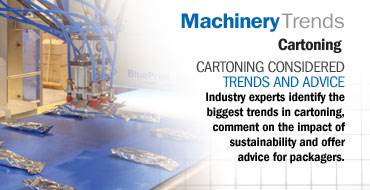
by Rick Lingle, Editor in Chief
To see a PDF of this article as it appears in print, Click Here
Participants:
Kim Mulholland-Callaghan, VP of Sales, The Aagard Group
Alan Beehler, VP and General Manager, BluePrint Robotics Div., BluePrint Automation
Dale Andersen, President & CEO, Delkor Systems
Ross Long, VP, Sales and Marketing, Kliklok-Woodman
F&BP: What’s the hottest trend affecting cartons and cartoning?
Dale Andersen: We are seeing a significant increase in the number of customers that require their top-load cartoning line to run both paperboard and corrugated cartons. This means both the carton formers and carton closers need to be designed to handle the full range of paperboard cartons as well as a wide range of corrugated formats from micro-flute to standard B and C flutes. This trend is very much coupled with the broader industry trend for Retail Ready and Shelf Ready packaging formats. Where a standard paperboard carton may have been sufficient before, marketing now is looking at how to make that carton a one-way shipper via the creative use of corrugate.
What is interesting about the combination of both corrugate and paperboard into a cartoning line is that it changes the basic design of the equipment. The traditional paperboard carton former is not designed for corrugated, and likewise the traditional corrugated former is not designed for paperboard.
Ross Long: Flexibility is king. Customers today are looking for the ability to either lock form or glue form their top load cartons and in a wider size range than we’ve seen in the past. In end-load cartoning, package size range flexibility and new carton shapes or features to help differentiate the product on the store shelf have gained importance.
Alan Beehler:One trend we have been involved with is customizing the carton blank to allow more room for loading tight-fitting products. The finished package remains unchanged but by moving some of the forming operations to the closer, we feel that robotic loaders have more freedom of movement when loading the cartons.
Kim Mulholland-Callaghan: We’re seeing material savings through total carton fill and smaller cartons with the same amount of product. In addition to material savings, manufacturers are adding more cartons (product) to each pallet providing significant savings in transportation costs throughout the supply chain.
F&BP: What effect has sustainability had?
Long: Sustainability points are high for paperboard because of the recyclable nature of the materials. Increasingly, we’re being asked to run thinner-caliper materials to reduce materials even further. Related to the first question, new package styles are being tested that reduce the overall material use – such as the innovative “open corner” cartons being used by one of the largest frozen entrée producers for a steamed entrée. This carton is challenging to run because it doesn’t have the stability of a typical end-load carton; however, KW designed a new carton feed and transport system to handle the carton without sacrificing packaging speeds.
We’re also seeing increased interest in sleeves and even “watchband” cartons and have designed some of our equipment to give the manufacture to run these style “wraps” on the same machine they run conventional seal end cartons.
Mulholland-Callaghan:Sustainability has become more ubiquitous through the entire supply chain. Manufacturers are being rewarded for their sustainability initiatives by utility companies, federal, state and local programs and at the store level with incentives.
Andersen:It has placed more emphasis on precision forming and closing. If a carton is formed and closed properly (which also means correctly applying the right adhesive in the correct locations) the net result is a stronger carton, which means a more efficient use of materials. Precision forming and closing also results in less waste from damaged cartons, and higher line efficiency.
When it comes to the dual ability of running both paperboard and corrugated, we are seeing customers eliminating the secondary shipper by using a high graphic corrugated carton as a Retail Ready carton that doubles as a one-way shipper.
F&BP: What is one piece of advice you have for food and beverage packagers?
Beehler:Do your homework when purchasing and find a company with a good track record and one that you are comfortable working with. Also, demand an extensive acceptance test that includes many changeovers. If the equipment runs at 99.99% efficiency, but takes six or seven hours to changeover, your production numbers may not be acceptable.
Long:No packaging equipment decision is one-sided any longer – say speed over size range or machine cost. The food marketers are being very innovative in package design and format so as to wring every bit of differentiation they can on a crowded supermarket shelf. The days of expecting a line to run the same product for years, in the same carton, are over; so make sure that the equipment you select offers flexibility to meet the changes your marketing team will expect.
Andersen:It is hard to define what the market will look like in two years, but few companies can afford to invest in new machinery every couple of years to meet these changing demands. I would recommend they invest in equipment that has flexibility and versatility engineered into the design.
Mulholland-Callaghan:
Ask yourself these questions:
1. Is your company’s legacy drag stagnating your opportunity to attain the competitive advantage your suppliers are capable of giving you?
2. Is acceptance of the “traditional” way of doing things preventing you from pursuing “game changing” opportunities or innovation?
For More Information
The Aagard Group, LLC
320-763-6043;www.aagard.com
BluePrint Robotics, Div. BluePrint Automation
804-520-5400;www.blueprintautomation.com
Delkor Systems
763-783-0855;www.delkorsystems.com
Kliklok-Woodman
770-981-5200; www.klikwood.com
